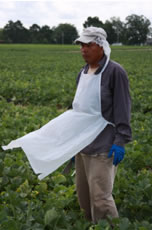Good Agricultural Practices
go.ncsu.edu/readext?280113
en Español / em Português
El inglés es el idioma de control de esta página. En la medida en que haya algún conflicto entre la traducción al inglés y la traducción, el inglés prevalece.
Al hacer clic en el enlace de traducción se activa un servicio de traducción gratuito para convertir la página al español. Al igual que con cualquier traducción por Internet, la conversión no es sensible al contexto y puede que no traduzca el texto en su significado original. NC State Extension no garantiza la exactitud del texto traducido. Por favor, tenga en cuenta que algunas aplicaciones y/o servicios pueden no funcionar como se espera cuando se traducen.
Português
Inglês é o idioma de controle desta página. Na medida que haja algum conflito entre o texto original em Inglês e a tradução, o Inglês prevalece.
Ao clicar no link de tradução, um serviço gratuito de tradução será ativado para converter a página para o Português. Como em qualquer tradução pela internet, a conversão não é sensivel ao contexto e pode não ocorrer a tradução para o significado orginal. O serviço de Extensão da Carolina do Norte (NC State Extension) não garante a exatidão do texto traduzido. Por favor, observe que algumas funções ou serviços podem não funcionar como esperado após a tradução.
English
English is the controlling language of this page. To the extent there is any conflict between the English text and the translation, English controls.
Clicking on the translation link activates a free translation service to convert the page to Spanish. As with any Internet translation, the conversion is not context-sensitive and may not translate the text to its original meaning. NC State Extension does not guarantee the accuracy of the translated text. Please note that some applications and/or services may not function as expected when translated.
Collapse ▲ Good Agricultural Practices (GAPs) are the basic environmental and operational conditions necessary for the production of safe, wholesome fruits and vegetables. The purpose of GAPs is to give logical guidance in implementing best management practices that will help to reduce the risks of microbial contamination of fruits and vegetables. Examples of GAPs include worker hygiene and health, manure use and water quality throughout the production and harvesting process. While the United States has one of the safest food supplies in the world, recent media attention on foodborne illness outbreaks underscores the importance of good agricultural practices.
Good Agricultural Practices (GAPs) are the basic environmental and operational conditions necessary for the production of safe, wholesome fruits and vegetables. The purpose of GAPs is to give logical guidance in implementing best management practices that will help to reduce the risks of microbial contamination of fruits and vegetables. Examples of GAPs include worker hygiene and health, manure use and water quality throughout the production and harvesting process. While the United States has one of the safest food supplies in the world, recent media attention on foodborne illness outbreaks underscores the importance of good agricultural practices.
Growers, packers and shippers are urged to take a proactive role in minimizing food safety hazards potentially associated with fresh produce. Being aware of and addressing the common risk factors outlined in GAPs will result in a more effective, cohesive response to emerging concerns about the microbial safety of fresh fruits and vegetables. Furthermore, operators should encourage the adoption of safe practices by their partners along the farm-to-family food chain. This includes distributors, exporters, importers, retailers, produce transporters, food service operators and consumers.
Navigation


